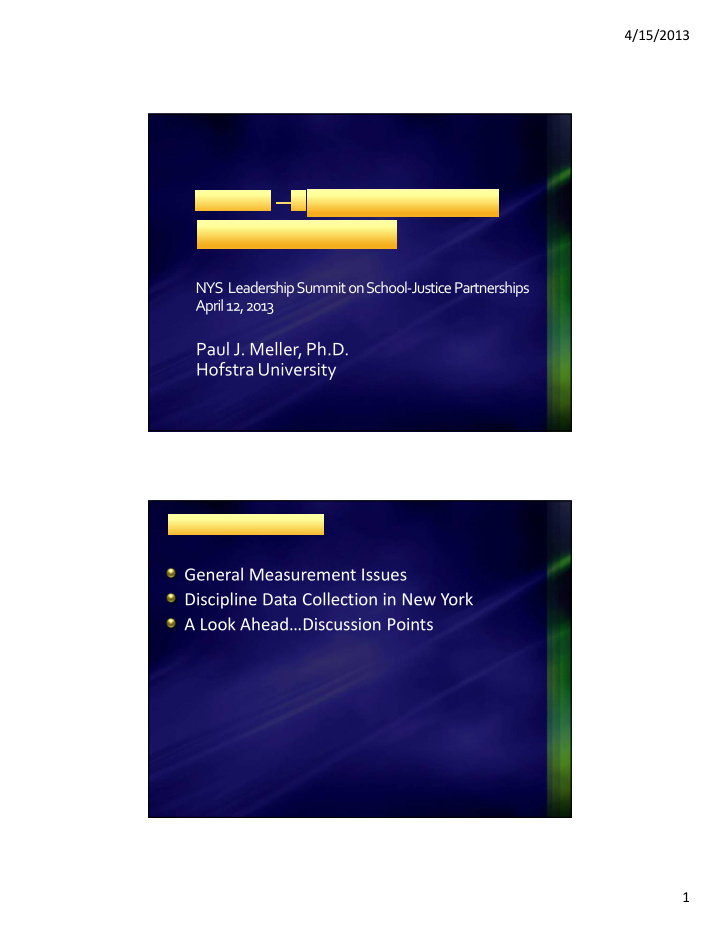



4/15/2013 NYS Leadership Summit on School-Justice Partnerships April 12, 2013 Paul J. Meller, Ph.D. Hofstra University General Measurement Issues Discipline Data Collection in New York A Look Ahead…Discussion Points 1
4/15/2013 Validity of Data • Integrity of Collection Methods • Specificity and Definitions of the Variables • Applications and Uses Uniform Definitions Uniform Applications of the Definitions 2010-2011 VADIR Data for Senior High Schools % Schools Mean % Schools Mean Reporting Minor Reporting Intimidation/H 0 Minor Altercations 0 arassment Altercations Intimidation/H arassment NYC 11.0% 16.9 19.6% 5.9 NYS 7.7% 14.0 14.8% 11.0 Minimizing Other Interests Annual Professional Performance Review (APPR) 2
4/15/2013 Photo spectrometer Take a look “The best laid schemes of mice and men often go awry.” -John Steinbeck 3
4/15/2013 In 2001 the No Child Left Behind Act (PL 107- 110 ) was enacted. NCLB required each state to develop criteria for identifying “persistently dangerous” schools. The Violent and Disruptive Incident Reporting System (VADIR) was developed and implemented to meet this mandate. Individual incidents and summative aggregate data regarding school violence and significantly disruptive incidences are reported Homicide Burglary Forcible Sex Criminal Mischief Other Sex Offenses Larceny/Theft Robbery Bomb Threat Assault w/serious injury False Alarm Arson Riot Kidnapping Weapon Possession Assault with injury Drug Possession Reckless Endangerment Alcohol Possession Minor Altercations Other Disruptive Behaviors Intimidation/Harassment 4
4/15/2013 The VADIR provides us with broad strokes regarding incidence and prevalence of large magnitude/high impact events in the school. Berkshire Junior-Senior High School Little Flower School Sandy Hook Elementary School It is not useful with low amplitude but chronic behavior events in the school. The unit of analysis for the VADIR is the school. While it can be helpful to determine which buildings may need building level intervention, the data collected does not focus on student level intervention. Data collected does not inform districts regarding the dynamics of the violent or disruptive behavior. It only addresses “what happened”, not “why” or “how”. Data collection methods also make the VADIR’s validity questionable. 5
4/15/2013 Specificity of the VADIR turns it’s focus to identifying those schools which are persistently violent or disruptive as indicated in NCLB. 6
4/15/2013 11 10 Persistently Non- Dangerous Dangerous 9 Schools Schools 12 8 7 The VADIR has limited usefulness due to problems with: • Integrity of Collection Methods • Specificity and Definitions of the Variables • Applications and Uses 7
4/15/2013 • DASA data reporting requirements improves upon the narrow scope of the original VADIR by broadening the scope of reporting of discipline issues to all material incidents of harassment and/or discrimination (VADIR PART 2). • Requires a reporting of the basis of the harassment or discrimination. • Expands data collection to include broad-based perceptions of student, parent, and teacher perceptions school safety and supports. While there is improvement in data collection demonstrated through the VADIR Part 2, there still are significant limitations in terms of helping school develop more effective discipline approaches. • No correction of problems inherent in VADIR Part 1. • Unit of Analysis is still too high. Successful data collection will help to inform decisions at the level of the school district, school building, and individual student. 8
4/15/2013 • Does not address other behavioral infractions that chronicity could still lead to exclusion from the class or school building. • DOES NOT INFORM INTERVENTION!! How do we move to better data collection which will allow for data-based decision making regarding interventions for school infractions at the individual student level as well as the school building and school district? How can we use data collected to assist school personnel to implement and modify evidence- based disciplinary plans based upon their effectiveness and history of the individual students? 9
4/15/2013 New York and the rest of the country has embraced a model of data driven interventions for student who are not progressing academically. Would a Response to Intervention (RTI) model provide the information necessary to make improvements on all three system levels? How do we benefit from the successes of other data driven approaches across the country such as in the Baltimore City Public Schools and the Denver Public Schools? 10
Recommend
More recommend